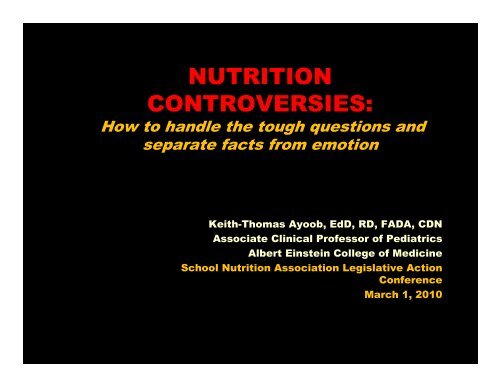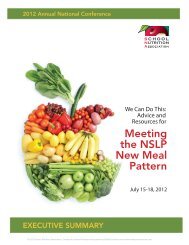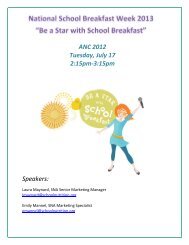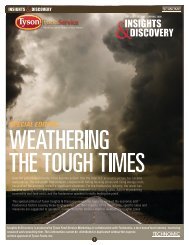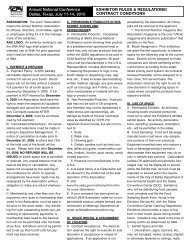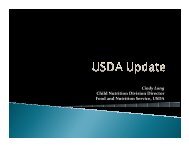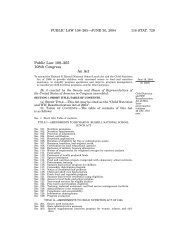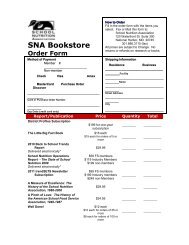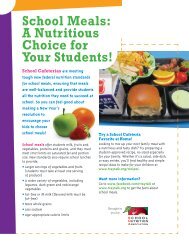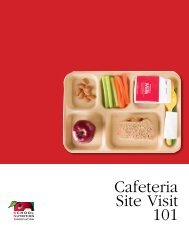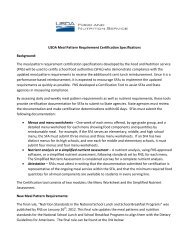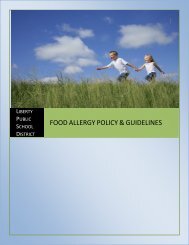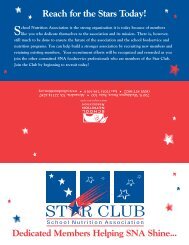NUTRITION CONTROVERSIES: - School Nutrition Association
NUTRITION CONTROVERSIES: - School Nutrition Association
NUTRITION CONTROVERSIES: - School Nutrition Association
You also want an ePaper? Increase the reach of your titles
YUMPU automatically turns print PDFs into web optimized ePapers that Google loves.
<strong>NUTRITION</strong><br />
<strong>CONTROVERSIES</strong>:<br />
How to handle the tough questions and<br />
separate facts from emotion<br />
Keith-Thomas Ayoob, EdD, RD, FADA, CDN<br />
Associate Clinical Professor of Pediatrics<br />
Albert Einstein College of Medicine<br />
<strong>School</strong> <strong>Nutrition</strong> <strong>Association</strong> Legislative Action<br />
Conference<br />
March 1, 2010
4 examples<br />
of “risky” topics<br />
• Food allergies<br />
• Sugar<br />
• Artificial colors<br />
• Sugar substitutes
Common thoughts…<br />
• “Change the menu, my kid is allergic”<br />
• Sugar is making kids<br />
Fat<br />
Hyperactive<br />
Diabetic<br />
High
More common thoughts…<br />
• “Artificial colors make them hyperactive”<br />
• “Sugar substitutes…<br />
Cause brain tumors/cancer/liver problems”<br />
Turn into formaldehyde in your body”<br />
Make you crave sweets”<br />
“Just HAVE to be bad – I read it on the<br />
Internet”
“OK, who doesn’t<br />
eat what?”<br />
Food<br />
Allergies
THE BIG 8<br />
• Peanuts<br />
• Eggs<br />
• Shellfish<br />
• Fish<br />
• Milk<br />
• Wheat<br />
• Soy<br />
• Tree nuts
THE BIG 8<br />
• Account for 80% of allergies<br />
• Most kids outgrow food allergies<br />
• Most are NOT life-threatening
Problems with special diets:<br />
• Labor intensive<br />
• Costly<br />
• May affect very few<br />
• Many varieties<br />
• Most not life-threatening
Special diets:<br />
Time to put our foot down?<br />
• First it was allergies<br />
• Then peanut-free tables/schools/lives<br />
• Limits of reasonable responsibility<br />
• Budgets, budgets, budgets<br />
• Rethinking the purpose of school lunch
GO TO HILL!<br />
• Tell your legislators:<br />
We do school lunch, not hospital lunch<br />
• Opt-out when below national average<br />
• Optional accommodation, based on<br />
budget or other considerations<br />
• Rally against forcing schools to outlaw<br />
allergic foods
A R T I F I C I A<br />
L<br />
C O L O R S
What ARE they?<br />
• Regulated by FDA<br />
• 2 kinds of colors in food:<br />
Certified color additives<br />
Colors exempt from certification
9 Certified colors<br />
• Blue #1<br />
• Blue #2<br />
• Green #3<br />
• Red #2<br />
• Red #3<br />
• Red #40<br />
• Orange B<br />
• Yellow #5<br />
• Yellow #6
Exempt colors<br />
• Naturally derived but are still color<br />
additives, must comply with regulations<br />
• More expensive<br />
• May impart flavors
What are they doing in our food?<br />
• Compensate for color losses<br />
• Maintain uniformity when colors naturally<br />
vary<br />
• Enhance naturally occurring colors<br />
• Give color to colorless foods
THE BIG QUESTION:<br />
DO COLORS IN FOOD<br />
CAUSE HYPERACTIVITY?
HISTORY<br />
• Started with Feingold in the 1970s<br />
• Hyperactivity caused by:<br />
Salicylates<br />
Artificial flavors<br />
Artificial colors<br />
Feingold, BF Delaware Med J 1977
Feingold phenomenon<br />
• Early studies were highly criticized:<br />
Lack of controls<br />
Small sample sizes<br />
Anecdotal reports<br />
Inability to link specific colors with behavior<br />
Inconsistent dosing<br />
poor methodology<br />
lack of subjectivity<br />
Feingold, BF Delaware Med J 1977<br />
…however………..
Review by<br />
Shab & Trinh (2004)<br />
• Meta-analysis<br />
• 15 DB-PC trials<br />
• Results:<br />
5 studies: increased ADHD symptoms<br />
8 studies: no significant increases in ADHD symptoms<br />
2 studies: DECREASED ADHD symptoms<br />
Only 2 trials received the highest validity score of “A”
Shab & Trinh (2004)<br />
• 8 crossover studies<br />
• Some effect seen in previously diagnosed<br />
hyperactive children BUT<br />
• Serious flaws in many studies<br />
2 had no washout period<br />
3 had “unorthodox outcome measures”<br />
None had a validity rating of “A”<br />
One had imperfect blinding
Problems with studies on ACs<br />
and hyperactivity<br />
• Who’s doing the ratings?<br />
• Does the test ask all the right questions?<br />
• Include/exclude children on medication?<br />
• Include/exclude non-hyperactive children?<br />
• Include a washout period?
Bateman et al (2004)<br />
• Randomized, DB-PC crossover trial<br />
• 277 4-year-olds<br />
• 20-mg of colors + 45 mg of sodium<br />
benzoate<br />
• Ratings by parents AND teachers
Bateman et al (2004)<br />
• Teacher ratings of hyperactivity:<br />
No behavioral difference between placebo<br />
and AC periods<br />
• Parent ratings:<br />
Hyperactivity noted with BOTH placebo and<br />
AC periods<br />
Slightly greater with AC
Bateman et al (2004)<br />
Authors concluded:<br />
Some effect detectable by parents but not by typical clinic<br />
setting<br />
Weaknesses:<br />
Teachers saw no changes in classroom settings<br />
Parents saw more hyperactivity even with placebo.<br />
AC and Na benzoate mixed – unclear which component<br />
would explain results<br />
No dose response
McCann et al (2007)<br />
N = 153 144<br />
3 yo 8/9 yo Composition<br />
Mix A 20 mg AC 25 mg AC 4 AC + Na<br />
benzoate<br />
Mix B 30 mg AC 62 mg AC 4 AC + Na<br />
benzoate<br />
• General population<br />
• Double-blind, placebo-controlled<br />
•Global hyperactivity aggregate scores
McCann et al (2007)<br />
• Comparing Mix A against placebo, Mix B<br />
against placebo:<br />
3 y.o.: in both cases, Mix showed significantly<br />
greater hyperactivity scores<br />
8/9 y.o.: in both cases, Mix showed<br />
significantly greater hyperactivity scores<br />
…but….
McCann et al (2007)<br />
• When adjusted for:<br />
Week during trial<br />
Sex<br />
Maternal education<br />
SES<br />
GHA in baseline week<br />
Pretrial diet………
McCann et al (2007)<br />
• Effect in 8/9 y.o., was significant only at<br />
highest dose (Mix B)<br />
• Effect in 3 y.o. was significant only at the<br />
lower dose (Mix A).
McCann et al (2007)<br />
Among authors’ conclusions:<br />
“…substantial individual differences in the<br />
response of children to the additives.”
Conclusions of EFSA panel<br />
• Mixes make it impossible to know<br />
effects/lack thereof of individual colors<br />
• Inconsistency in results re: age, sex, type<br />
of observer<br />
www.efsa.europa.eu
Conclusions of EFSA panel<br />
• “…the study provides limited evidence<br />
that the two mixtures had a small and<br />
statistically significant effect on activity<br />
and attention.”<br />
• They also concluded that the McCann<br />
study did not provide an acceptable basis<br />
for altering the ADI for colors.<br />
EFSA Journal, 2008
Guidance<br />
• Perceived or real, some subset of children<br />
may be especially sensitive or highresponders<br />
to ACs<br />
• Look at quantity/frequency<br />
4 oz. of candy for a 3-year-old and<br />
8 oz. of candy for an 8-y.o. is EXCESSIVE<br />
Smaller amounts may matter little or none<br />
• Assess context, setting, situation
Guidance<br />
• Most ACs appear in “treat” foods & soda.<br />
• Focus on limiting treats<br />
and intake of ACs will decline<br />
Diet quality may improve<br />
• Only applies to Certified colors – exempt<br />
colors are not implicated
SUGAR<br />
SUGAR<br />
SUGAR
The buzz<br />
• Sugar gets kids hyperactive<br />
• Sugar makes kids overweight<br />
• HFCS: The new trans fat. It gives you<br />
diabetes, metabolic syndrome, etc.<br />
• Fructose causes high blood pressure.
How much sugar do we eat?<br />
• Total added sugars eaten, per capita 1 :<br />
1999: 107.7 lb.<br />
2007: 97.0 lb. (=120 gm/day)<br />
1 - ers.usda.gov, accessed 9/21/09
Sources of All Simple Sugars<br />
Present in Children’s’ Diets<br />
RTE cereals, 5.1%<br />
Fruits, 13.3%<br />
(15.4%)<br />
Sugars and sweets<br />
including candy, 11.9%%<br />
Vegetables, 2.1%<br />
Carbonated soft<br />
drinks, 16.8%<br />
(49.5%)<br />
Milk, milk products,<br />
22.2%<br />
(29.1%)<br />
Fruitades and other beverages,<br />
12.6%<br />
Source:<br />
Bell Institute for Health & <strong>Nutrition</strong><br />
Cakes, cookies, pies<br />
and pastries, 8.2%<br />
Meat, poultry, fish and<br />
mixtures, 1.4%<br />
All other grain products,<br />
5.5%<br />
Misc. = 0.9<br />
NHANES 2001-02
What kind are we getting?<br />
www.ers.usda.gov, 2009
HFCS: the evil of the<br />
moment<br />
• 2 basic kinds:<br />
HFCS 42: 42% fructose<br />
HFCS 55: 55% fructose<br />
• Cane sugar (sucrose):<br />
50% fructose<br />
• Take-away message: HFCS is really not<br />
high in fructose
What IS high in fructose:<br />
• Apple juice:<br />
65% fructose, 35% glucose<br />
• Pear juice:<br />
74% fructose, 26% glucose
Sugar, HFCS, and obesity?<br />
• Evidence suggests<br />
otherwise<br />
• IOM report (2002):<br />
Higher intakes of sugar are<br />
associated with lower rates<br />
of obesity<br />
“No clear and consistent<br />
association between<br />
increased intake of added<br />
sugars and BMI.”
Sugar & HFCS and obesity -- NOT<br />
• Inverse relationship found between sugar<br />
intake and bodyweight or BMI:<br />
Saris (2003)<br />
Hill & Prentice (1995)<br />
• Inverse relationship between total sugar<br />
intake and total fat intake:<br />
Gibson (1996)
Sucrose and weight loss, satiety<br />
• 42 women – two groups<br />
All on low-fat, low calorie diets<br />
1 group consumed 43% of energy as sugar<br />
• Result:<br />
No differences in weight loss, mood, hunger,<br />
stress level<br />
Equal decreases in BP, %BF, plasma lipids<br />
Surwit, AJCN 1997
Sugar & hyperactivity:<br />
How the rumors started<br />
• Case study of 1 child by Crook (1974)<br />
Sugar was removed, behavior improved<br />
• Controlled studies unable to replicate<br />
results
Sugar and behavior<br />
• Negative associations generally dismissed<br />
by the scientific community 1<br />
• Perception of sugar by parents and<br />
consumers continues to defy years of<br />
sound science and logic.<br />
• Some evidence that behavior is positively<br />
affected by sugar.<br />
1 – IOM, Dietary carb, 2002
Meta-analysis by<br />
Wolraich, et al (1995)<br />
• 23 studies<br />
Double blinded, placebo-controlled<br />
Known quantity of sugar<br />
Reported statistics useful for computing<br />
dependent measures
Meta-analysis by<br />
Wolraich, et al (1995)<br />
• Conclusion:<br />
“Sugar does not affect the behavior or<br />
cognitive performance of children. The strong<br />
belief of parents may be due to expectancy<br />
and common association.”<br />
In fact…….
Sugar can even IMPROVE<br />
behavior and performance<br />
• Decrease in activity after sucrose 1 or<br />
glucose 2<br />
• Sugar-containing snack can enhance<br />
ability to stay on task 3<br />
• Glucose enhances long-term verbal and<br />
spatial memory 4<br />
1 – Behar et al (1994); 2- Saravis et al (1990)<br />
3 – Busch et al (2002); 4- Sunram-Lea et al (2001)<br />
But….
How much is too much?<br />
• 2005 DGA allow for<br />
added sugars and fats<br />
• Discretionary calories<br />
include BOTH sugar and<br />
fat and assume that both<br />
are consumed<br />
Dietary Guidelines for Americans 2005
2005 DGA:<br />
Discretionary calories<br />
1400 cal/d 2000 cal/d 2400 cal/d<br />
Total DC 171 cal 267 cal 362 cal<br />
From fat 14 g 18 g 22 g<br />
From sugar 16 g 32 g 48 g<br />
Ref: 2005 US Dietary Guidelines for Americans
The sugar shake-down<br />
• Sugar’s not “angel food” but it’s not<br />
“devil’s food” either<br />
• It does NOT get kids “hyper”<br />
More likely to be situational<br />
• Not a matter of “good” or “bad” but “how<br />
much” and “how often”
Recommendations<br />
Dietary Guidelines for Americans 2005<br />
• Spend wisely<br />
• Quantity matters,<br />
frequency matters<br />
• Type of sugar doesn’t<br />
matter<br />
• Most kids need to reduce<br />
their added sugar intake<br />
• WON’T make kids<br />
hyperactive!
AAP Policy Statement: Prevention of<br />
pediatric overweight & obesity<br />
“Dietary practices should be fostered that<br />
encourage moderation rather than<br />
overconsumption, emphasizing healthful<br />
choices rather than restrictive eating<br />
patterns.”
AAP Policy Statement:<br />
Soft drinks in schools<br />
• Each 12-oz sugared soft drink consumed daily<br />
has been associated with a 0.18-point increase<br />
in a child’s BMI and a 60% increase in risk of<br />
obesity, associations not found with "diet"<br />
(sugar-free) soft drinks. Sugar-free soft drinks<br />
constitute only 14% of the adolescent soft drink<br />
market.<br />
American Academy of Pediatrics, 2004
BOTTOM LINE<br />
• Sugar’s OK<br />
• Not too much<br />
• Mostly fruit
IOM Report on<br />
<strong>School</strong> Meals<br />
• Safe for all ages<br />
• One of the most<br />
rigorously tested<br />
ingredients in the<br />
U.S. food supply<br />
• Can’t use it until high<br />
school
Where we’re getting our<br />
sugar subs: 2006*<br />
Application<br />
% of Total by Weight<br />
Beverages 57.7<br />
Tabletop sweeteners 12.1<br />
Personal care products 11.8<br />
Food 9.1<br />
Other 9.3<br />
* Based on low calorie sweetener sales to the processed<br />
food and beverage industry.<br />
SRI Consulting Chemical Handbook. 2007
Aspartame: Product History<br />
• Approved in 1981<br />
• 180-200 times sweeter than sucrose<br />
• In more than 6,000 products and is<br />
consumed by over 200 million people<br />
globally, including:<br />
• One of the most rigorously tested<br />
ingredients in the U.S. food supply<br />
www.aboutaspartame.com
Aspartame:<br />
Metabolism & Excretion<br />
• Aspartame is metabolized to 3 (and ONLY 3) common<br />
dietary components:<br />
Aspartic acid<br />
Phenylalanine<br />
Methanol<br />
• Absorption and metabolism of constituents the same<br />
whether derived from aspartame or other food products*<br />
*Stegink et al. The Clinical Evaluation of a Food Additive. New York, NY. CRC<br />
Press; 1996.
PHE Content of Aspartame-Sweetened Beverage<br />
Compared with Common Foods (in mg)<br />
1059<br />
934<br />
606<br />
332<br />
90
Methanol in Aspartame-sweetened<br />
Beverage vs. Common Foods (mg)<br />
(Wucherphennig et al. Flussuges Obst. 348-354, 1853).
Acceptable Daily Intake:<br />
ADI for Aspartame: 50 mg/kg bw/day<br />
• Consumption by high consumers (90 th<br />
percentile in the general population,<br />
including children), is between 5-10%<br />
of the ADI**<br />
• Diabetics average 6.6%**<br />
*Renwick, A. G. (2006) The intake of intense sweeteners-An update review. Food<br />
Additives and Contaminants 4: 327-338.<br />
** J Am Diet Assoc. 2004; 104:255-275.
Some of the safety concerns<br />
listed on the Internet<br />
• Possibility of toxicity from methanol<br />
• Elevations in plasma concentrations of phenylalanine<br />
and aspartic acid (altering brain’s neurochemical<br />
composition)<br />
• Possibility of neuroendocrine changes<br />
• Possible carcinogenic risk<br />
• Postulated link with epilepsy and brain tumors<br />
• Allegations of ailments from infertility to baldness
Highlights of Global<br />
Safety Confirmation<br />
• Over 500 toxicological and clinical studies conducted<br />
over 30 years confirm safety<br />
• Regulatory authorities in more than 100 countries have<br />
approved aspartame for use:<br />
European Food Safety Authority (EFSA) Re-Confirms Safety of<br />
Aspartame (May 2006)<br />
Scientific Committee on Food (SCF) of European Commission<br />
Reconfirms Aspartame’s Clean Bill of Health-(December 2002)<br />
U.K. Food Standards Agency supports conclusions of SCF-<br />
(December 2002)<br />
French Food Safety Agency Supports Safety of Aspartame-(May<br />
2002)
Highlights of Global<br />
Safety Confirmation<br />
• Regulatory authorities in more than 100<br />
countries have approved aspartame for use:<br />
Health Canada Reaffirms Aspartame’s Safety-<br />
(February 2003)<br />
Joint Expert Committee on Food Additives of the<br />
WHO concluded that Aspartame is safe<br />
The UN’s Food and Agricultural Organization (FAO)<br />
has concluded that Aspartame is safe
Safety Confirmation: USA<br />
• American Diabetes <strong>Association</strong><br />
• American Dental <strong>Association</strong><br />
• ADA Position Paper, “Use of Nutritive and Non-<br />
Nutritive Sweeteners”<br />
• American Medical <strong>Association</strong> Council on<br />
Scientific Affairs<br />
• American Academy of Pediatrics, Committee on<br />
<strong>Nutrition</strong><br />
• American Cancer Society
Assessed Across Many Subgroups
2007 Expert Panel on Aspartame<br />
• Goal = convene an independent international panel of toxicology<br />
experts to review all scientific studies and assess the safety of<br />
current consumption of aspartame.<br />
• Blinded study with Ajinomoto funding: Panelists identity unknown<br />
(each side); no conflicts of interest or contact with company<br />
• Experts: Food toxicology, metabolism, carcinogenesis, pathology,<br />
neurotoxicology, epidemiology, toxicology of methanol &<br />
formaldehyde<br />
• Panel spent 11 months reviewing > 500 scientific articles and<br />
reports on aspartame from over the past 30 years<br />
• NHANES data to determine how much aspartame consumed by<br />
average person<br />
Magnuson Aspartame: A safety evaluation based on current use levels, regulations, and toxicological<br />
and epidemiological studies. Critical Reviews in Toxicology. 2007. 37(8):629-727.
Expert Panel Findings-<br />
Safe across Population Groups<br />
• No credible evidence aspartame is carcinogenic or has<br />
any cancer-causing properties<br />
• Extensive human studies: No link to memory loss,<br />
learning problems or any other neurological effects<br />
• No effect on behavior, brain function or seizures in any of<br />
the groups studied<br />
• No adverse effects on reproduction or lactation<br />
• Safe for use by people with diabetes and may help them<br />
adhere to a lower-carbohydrate diet program to better<br />
control blood sugars<br />
Magnuson Aspartame: A safety evaluation based on current use levels, regulations, and toxicological<br />
and epidemiological studies. Critical Reviews in Toxicology. 2007. 37(8):629-727.
The Ramazzini Study<br />
• Largest (and worst) animal study ever done on<br />
Aspartame.<br />
• 1,800 (male and female) 8 wk old rats<br />
• Very low to very high concentrations:<br />
• “Statistically significant dose-related increase in<br />
lymphomas and leukemias in females”<br />
• No significant increase in brain tumors<br />
Soffriti et. al. Aspartame induces lymphomas and leukemias in rats. Eur. J.<br />
Oncol., vol. 10, no. 2, pp. 108-116.
The Ramazzini Study:<br />
International Response<br />
Study widely criticized by experts due to numerous flaws in design,<br />
implementation and data reporting<br />
Conflicts with large body of credible studies thoroughly reviewed by<br />
regulatory authorities around the world<br />
Not a single regulatory body endorsed findings; cite large database<br />
of credible evidence showing absence of a carcinogenic effect<br />
Design and execution did not follow international protocol for animal<br />
carcinogenicity studies (or that of the National Toxicology Program)<br />
UK Committee on Carcinogenicity of Chemicals in Food criticized<br />
study design: statistical approach used did not fully adjust for agerelated<br />
effects<br />
Would not provide access by outside pathologists to analyze all of<br />
the tissue samples where cancerous tumors were found (standard<br />
practice)
2006 NIH/NCI Research<br />
• Conducted independently of any funding<br />
or ties to industry groups<br />
• Subjects included 556,990 men and<br />
women<br />
• Five years of follow up -1995-2005<br />
Lim et al. Prospective study of aspartame-containing beverages and risk of hematopoietic and brain<br />
cancers, Cancer Epidemiol Biomarkers Prev 2006;15(9). September 2006
2006 NIH/NCI Research Results<br />
• Increasing consumption NOT ASSOCIATED with any risk<br />
of cancer<br />
• NO ASSOCIATION with subtypes of cancers reported in<br />
the Ramazzini study<br />
Lim et al. Prospective study of aspartame-containing beverages and risk of hematopoietic<br />
and brain cancers, Cancer Epidemiol Biomarkers Prev 2006;15(9). September 2006
Aspartame &<br />
better diet quality<br />
• “Reported Use of Reduced-Sugar Foods<br />
and Beverages Reflects High-Quality<br />
Diets”<br />
“Reduced-sugar food users” consistently reported<br />
significantly higher intakes of fruit, similar or higher<br />
micronutrient intakes, lower energy intakes and lower<br />
intake of discretionary fat and added sugars.<br />
-J Food Sci. Vol. 70, Nr.1, 2005, S42-S46.
So…<br />
Going forward,<br />
there are challenges…
The challenge<br />
• Acknowledge there’s difference between<br />
philosophy/ideology and sound science<br />
• Provide the facts about high-emotion<br />
topics, based info on SOUND science<br />
• Advocate for science-based legislation!
Working THE HILL…<br />
• Parents/elected officials/constituents are<br />
under no obligation to adhere to sound<br />
science. WE are.<br />
• Lobby for legislation WITH FUNDING


